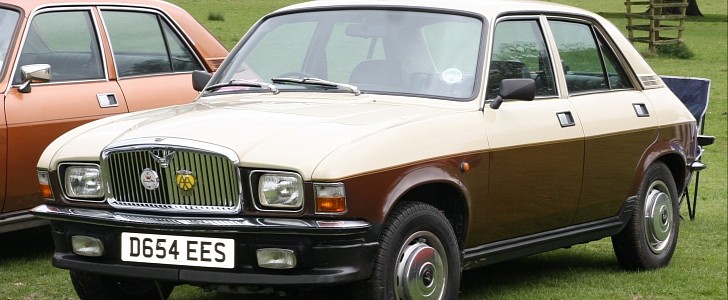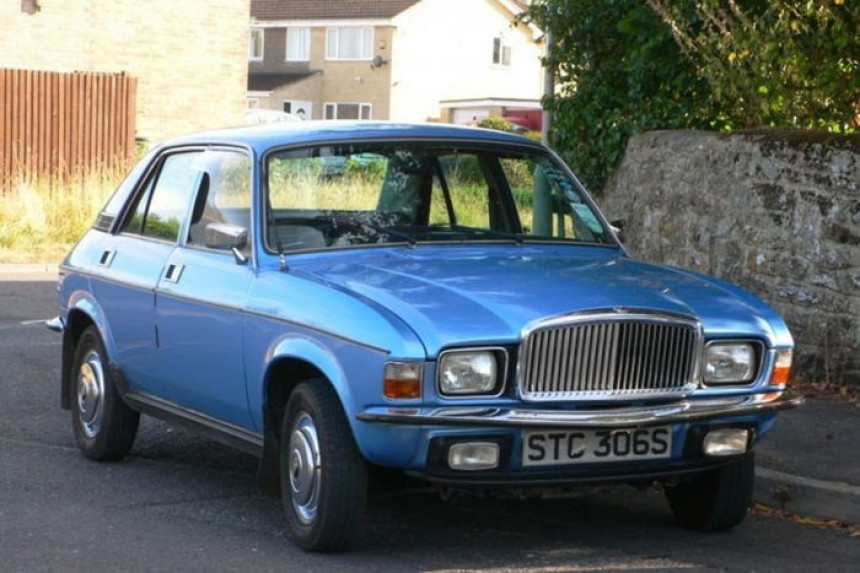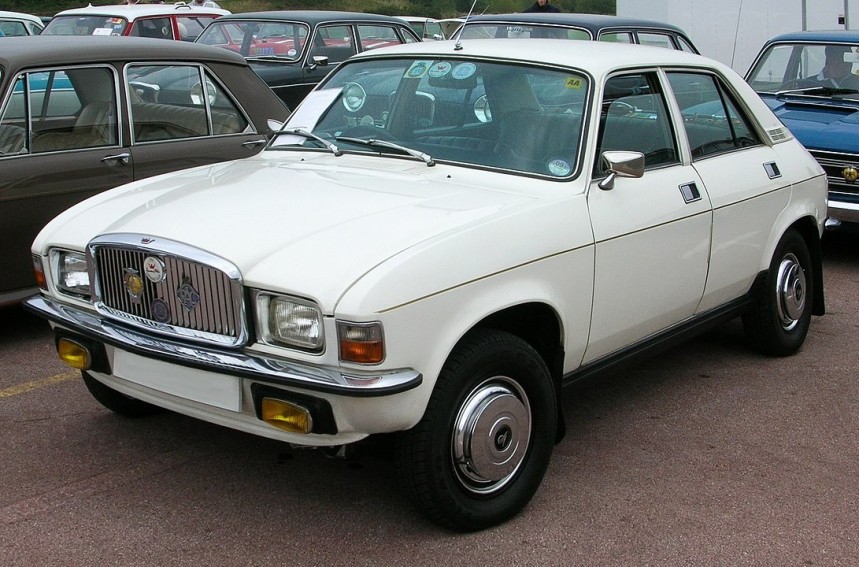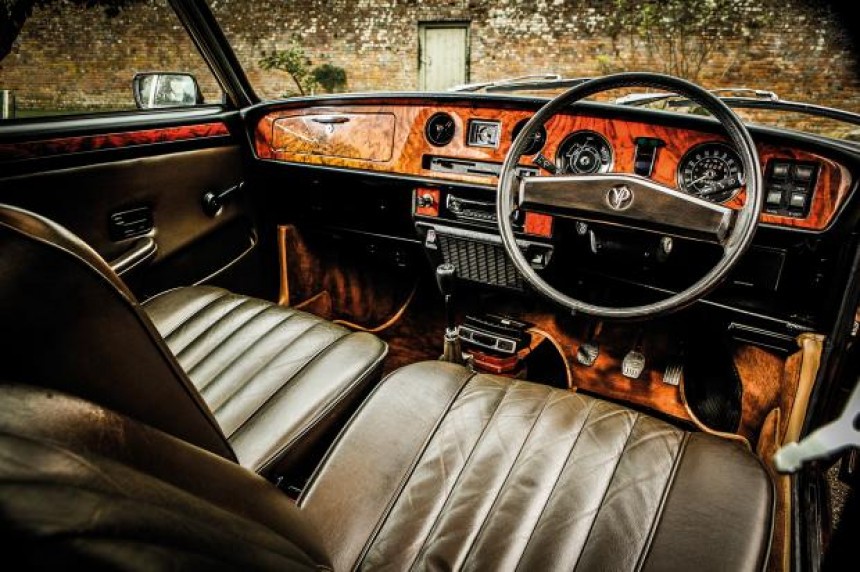Do you think some of the nonsensical and gnat IQ business moves American automakers have made in the last 25 years hurt your brain? Well, we hope you have some aspirin handy. Why? Because the British auto industry of the late 70s made even less sense.
Our resident automotive encyclopedia Andrew Nabors recently showcased an in-depth feature story about how the British automotive sector lost every single one of its native car brands between the late 1960s and mid-2000s. Go check that out if you want to learn more. But in short, we think the best lens through which to view the tomfoolery that so often took place in British car companies is to look at a supposed "special edition" from their hands down biggest train wreck of a company.
Ladies and gentelman, this is the Austin Allegro Vanden Plas. A bad upper-level economy car on a bad platform built by people spent around as much time on strike as they did building the things. Far be it from us to critique the common workers protesting for higher pay, better benefits, and improved working conditions. But once you look at the cars these factory workers had to slap together, no wonder they were fed up with their bosses.
In the case of the Allegro, it wasn't like the thing didn't have more than enough competition to look up to. By the early 1970s, the quirky but magnificent brothers of the Citroen DS, the GS, and the Italian Alfa Romeo Alfasud showcased to all of Europe the design language that would define family cars from the continent. Later on, these would evolve into the first hot hatchbacks. Even if they themselves weren't technically hatchbacks.
Make no mistake, British Leyland was hopeful the Allegro Vanden Plas would be a crown jewel in a lineup that helped the Brits from Cowley, Oxfordshire, keep up with the incoming wave of Hondas and Toyotas. A wave that many people had already begun to ride across the United Kingdom. It was also supposed to be just as refined and just as fun to drive as the aforementioned Alfasud.
But whereas the Alfasud had a strong but rust-prone foundation, the Allegro Vanden Plas was a wedge of British Government cheese with an underpowered glorified boat anchor for an engine. The Austin A-Series and subsequent E-Series engines may have been perfectly fine for, say, the early 1950s. But by the early 1970s, the British Motorway was capable of handling vehicles profoundly more powerful.
For some context, the 1,098-cc (67.0-cubic inch) A-Series inline-four in the inaugural year of the Allegro Vanden Plas made 49 horsepower at 5250 rpm and 60 pound-feet of torque at 2450 rpm. In fairness, such an engine was brilliant in the light and agile Austin/ British Leyland Mini. But in a four-door executive sedan, it was hopeless. But most fun hatchbacks and hatchback-adjacent cars weren't awesome because of their raw power.
For those not in the know, Vanden Plas was one of British Leyland's contracted coachbuilding subsidiaries. Apart from the Allegro, they're notable for adding their own touches to the highest-priced Austin Princess models. They've since ceased to be a relevant brand for the last 45 years or so. Does that bode well for this little Allegro?
Maybe the Vanden Plas could make up for its paltry engine with an innovative suspension? On the face of it, you'd be right but also dead wrong. The Hydragas hydraulic suspension unique to British Leyland vehicles of this time was the brainchild of the brilliant English inventor Alex Moulton. The same man behind the suspension system in the original Mini.
It consisted of a series of fluid-filled dampeners that were designed to cushion the occupants of the vehicle on a proverbial pillow of hydraulic pressure as it traversed over potholes, bumps, and roadkill. In theory, a small car with a modest wheelbase like the Allegro should benefit the most of all from a suspension of this variety.
But in reality, the intricate and complicated design often led to either the front, rear, or both ends of the car sagging to the ground like an early 2000s Lincoln Navigator. As it happens, both the Navigator and the Allegro were somewhat notorious for their suspensions going on the fritz in hilarious fashion.
The biggest difference between them was the Allegro being spared from becoming a meme because the Internet didn't exist yet. Couple that with the Morris Marina underpinnings, and you have a recipe for pure comedy. Even if British Leyland took it about as seriously as a perpetual air raid siren.
Comedy is somewhat of a theme when it comes to the Allegro, but especially its Vaden Plas Special Edition. Perhaps that's why there are indeed people in Britain who genuinely love these cars. Most of a certain age will remember when Jeremy Clarkson humorously compared the Allegro to its Morris Marina cousin.
We can see just how attached Allegro and even Marina owners are to their vehicles, even as Clarkson crassly and abrasively tries to convince them they're steaming garbage piles. The Allegro may not have lit the world on fire
in its day. But seeing the way its owners staunchly support their beloved cars in the face of relentless quips and jesting is, if nothing else, very admirable.
Ladies and gentelman, this is the Austin Allegro Vanden Plas. A bad upper-level economy car on a bad platform built by people spent around as much time on strike as they did building the things. Far be it from us to critique the common workers protesting for higher pay, better benefits, and improved working conditions. But once you look at the cars these factory workers had to slap together, no wonder they were fed up with their bosses.
In the case of the Allegro, it wasn't like the thing didn't have more than enough competition to look up to. By the early 1970s, the quirky but magnificent brothers of the Citroen DS, the GS, and the Italian Alfa Romeo Alfasud showcased to all of Europe the design language that would define family cars from the continent. Later on, these would evolve into the first hot hatchbacks. Even if they themselves weren't technically hatchbacks.
Make no mistake, British Leyland was hopeful the Allegro Vanden Plas would be a crown jewel in a lineup that helped the Brits from Cowley, Oxfordshire, keep up with the incoming wave of Hondas and Toyotas. A wave that many people had already begun to ride across the United Kingdom. It was also supposed to be just as refined and just as fun to drive as the aforementioned Alfasud.
For some context, the 1,098-cc (67.0-cubic inch) A-Series inline-four in the inaugural year of the Allegro Vanden Plas made 49 horsepower at 5250 rpm and 60 pound-feet of torque at 2450 rpm. In fairness, such an engine was brilliant in the light and agile Austin/ British Leyland Mini. But in a four-door executive sedan, it was hopeless. But most fun hatchbacks and hatchback-adjacent cars weren't awesome because of their raw power.
For those not in the know, Vanden Plas was one of British Leyland's contracted coachbuilding subsidiaries. Apart from the Allegro, they're notable for adding their own touches to the highest-priced Austin Princess models. They've since ceased to be a relevant brand for the last 45 years or so. Does that bode well for this little Allegro?
Maybe the Vanden Plas could make up for its paltry engine with an innovative suspension? On the face of it, you'd be right but also dead wrong. The Hydragas hydraulic suspension unique to British Leyland vehicles of this time was the brainchild of the brilliant English inventor Alex Moulton. The same man behind the suspension system in the original Mini.
But in reality, the intricate and complicated design often led to either the front, rear, or both ends of the car sagging to the ground like an early 2000s Lincoln Navigator. As it happens, both the Navigator and the Allegro were somewhat notorious for their suspensions going on the fritz in hilarious fashion.
The biggest difference between them was the Allegro being spared from becoming a meme because the Internet didn't exist yet. Couple that with the Morris Marina underpinnings, and you have a recipe for pure comedy. Even if British Leyland took it about as seriously as a perpetual air raid siren.
Comedy is somewhat of a theme when it comes to the Allegro, but especially its Vaden Plas Special Edition. Perhaps that's why there are indeed people in Britain who genuinely love these cars. Most of a certain age will remember when Jeremy Clarkson humorously compared the Allegro to its Morris Marina cousin.
in its day. But seeing the way its owners staunchly support their beloved cars in the face of relentless quips and jesting is, if nothing else, very admirable.










